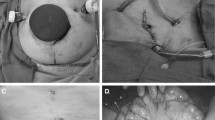Abstract
Purpose
The hepatic bridge as an anatomical variation may lead to recurrence and treatment failure in cytoreductive surgery (CRS) and hyperthermic intraperitoneal chemotherapy (HIPEC) by constituting an obscure region during surgery. This report aimed to highlight the relationship between the hepatic bridge and various prognostic factors in peritoneal carcinomatosis.
Methods
Data of 101 patients who underwent CRS/HIPEC for peritoneal carcinomatosis in a single centre were retrospectively reviewed. Demographic characteristics, primary origin of peritoneal carcinomatosis, classification of hepatic bridge, Peritoneal Cancer Index (PCI) score, and completeness of cytoreduction (CC) score were analysed.
Results
The tumour was proven histopathologically in 18 (28.6%) of 63 patients who underwent distal round ligament (DRL) resection. The PCI score was found to be significantly higher in patients with tumour in DRL compared to the ones without tumour (p < 0.001). The median PCI score of patients with implant positive DRL was 18 (12–20) and this score was 3 (2–6) for patients with implant negative DRL (p < 0.001). The ROC curve concerning the risk of an implant penetrating the round ligament revealed the optimal cut-off value of PCI at 10 with 88.9% sensitivity and 79.3% specificity.
Conclusion
The round ligament should be removed, regardless of the PCI score, as a standard in mucinous adenocarcinoma of the appendix and malignant peritoneal mesothelioma. DRL should be removed when PCI is equal or higher than 10 for PC due to colorectal and ovarian cancers.



Similar content being viewed by others
Data availability
Not applicable.
Code availability
Not applicable.
References
Chang SJ, Hodeib M, Chang J, Bristow RE (2013) Survival impact of complete cytoreduction to no gross residual disease for advanced-stage ovarian cancer: a meta-analysis. Gynecol Oncol 130:493–498. https://doi.org/10.1016/j.ygyno.2013.05.040
Aziz O, Jaradat I, Chakrabarty B, Selvasekar CR, Fulford PE, Saunders MP et al (2018) Predicting survival after cytoreductive surgery and hyperthermic intraperitoneal chemotherapy for appendix adenocarcinoma. Dis Colon Rectum 61:795–802. https://doi.org/10.1097/DCR.0000000000001076
Verwaal VJ, van Tinteren H, van Ruth S, Zoetmulder FA (2004) Predicting the survival of patients with peritoneal carcinomatosis of colorectal origin treated by aggressive cytoreduction and hyperthermic intraperitoneal chemotherapy. Br J Surg 91:739–746. https://doi.org/10.1002/bjs.4516
Yan TD, Bijelic L, Sugarbaker PH (2007) Critical analysis of treatment failure after complete cytoreductive surgery and perioperative intraperitoneal chemotherapy for peritoneal dissemination from appendiceal mucinous neoplasms. Ann Surg Oncol 14:2289–2299. https://doi.org/10.1245/s10434-007-9462-0
Baratti D, Kusamura S, Cabras AD, Dileo P, Laterza B, Deraco M (2009) Diffuse malignant peritoneal mesothelioma: failure analysis following cytoreduction and hyperthermic intraperitoneal chemotherapy (HIPEC). Ann Surg Oncol 16:463–472. https://doi.org/10.1245/s10434-008-0219-1
Ortega-Perez G, Sugarbaker PH (2002) Right psoas muscle/aortoiliac groove recurrence: an unusual anatomic site for progression of epithelial tumors of the appendix. Int Surg 87:212–216
Cabanas J, Gomes da Silva R, Goldstein P, Verghese M, Sugarbaker PH (2005) Recurrence of pseudomyxoma peritonei within the inguinal canal. Tumori 91: 481–6.
Cabanas J, Gomes da Silva R, Zappa L, Esquivel J, Cerruto C, Goldstein P, et al. (2006) Splenic metastases from mucinous neoplasms of the appendix and colon. Tumori 92: 104–12
Sugarbaker PH, Bijelic L (2008) The porta hepatis as a site of recurrence of mucinous appendiceal neoplasms treated by cytoreductive surgery and perioperative intraperitoneal chemotherapy. Tumori 94:694–700
Sugarbaker PH (2010) Pont hepatique (hepatic bridge), an important anatomic structure in cytoreductive surgery. J Surg Oncol 101:251–252. https://doi.org/10.1002/jso.21478
Sugarbaker PH (2018) The hepatic bridge. Eur J Surg Oncol 44:1083–1086. https://doi.org/10.1016/j.ejso.2018.03.031
McMullen JRW, Selleck M, Wall NR, Senthil M (2017) Peritoneal carcinomatosis: limits of diagnosis and the case for liquid biopsy. Oncotarget 8: 43481–90. https://doi.org/10.18632/oncotarget.16480
Paul BK, Ihemelandu C, Sugarbaker PH (2018) Prior surgical score: an analysis of the prognostic significance of an initial nondefinitive surgical intervention in patients with peritoneal carcinomatosis of a colorectal origin undergoing cytoreductive surgery and perioperative intraperitoneal chemotherapy. Dis Colon Rectum 61:347–354. https://doi.org/10.1097/DCR.0000000000001003
Sugarbaker PH (2019) Peritoneal tunnels: a site at risk for treatment failure when performing treatments for peritoneal metastases. A case series of 2 patients. Int J Surg Case Rep 61: 309–12. https://doi.org/10.1016/j.ijscr.2019.07.026
Saritha S, Ramani N, Yesender A (2015) Cadaveric study of morphological variations in the human liver and its clinical importance. Int J Med Sci Clinic Invent 2:1020–1031
Reddy N, Joshi SS, Mittal PS, Joshi SD (2017) Morphology of caudate and quadrate lobes of liver. J Evol Med Dent Sci 6(11):897–901
Chin J, O’Toole P, Lin J, Velavan SS (2018) Hepatic morphology: variations and its clinical importance. Eur J Anat 22:195–201
Halkia E, Kopanakis N, Valavanis C, Nikolaou G, Zouridis A, Vafias E et al (2015) Is cholecystectomy and removal of the round ligament of the liver a necessary step in cytoreductive surgery and HIPEC, for peritoneal carcinomatosis? Ann Ital Chir 86:323–326
Aydin N, Sardi A, Milovanov V (2016) Approach to the porta hepatis during cytoreductive surgery: technical considerations. Ann Surg Oncol 23:552–555. https://doi.org/10.1245/s10434-015-4872-x
Author information
Authors and Affiliations
Contributions
Study conception and design: Selcuk Gulmez, Mustafa Duman, Erdal Polat; acquisition of data: Aziz Serkan Senger, Orhan Uzun, Ayhan Oz, Omer Ozduman; analysis and interpretation of data: Ugur Duman, Ismail Ege Subasi, Erdal Polat; drafting of manuscript: Ugur Duman, Selcuk Gulmez, Erdal Polat, Mustafa Duman; critical revision of manuscript: Ugur Duman, Selcuk Gulmez.
Corresponding author
Ethics declarations
Ethics approval
2020/13/299.
Consent to participate
Not applicable.
Consent for publication
Not applicable.
Conflict of interest
The authors declare no competing interests.
Additional information
Publisher’s note
Springer Nature remains neutral with regard to jurisdictional claims in published maps and institutional affiliations.
Rights and permissions
About this article
Cite this article
Gulmez, S., Polat, E., Duman, U. et al. Hepatic bridge and round ligament of the liver during cytoreductive surgery: a retrospective cohort. Langenbecks Arch Surg 407, 1201–1207 (2022). https://doi.org/10.1007/s00423-021-02386-4
Received:
Accepted:
Published:
Issue Date:
DOI: https://doi.org/10.1007/s00423-021-02386-4




